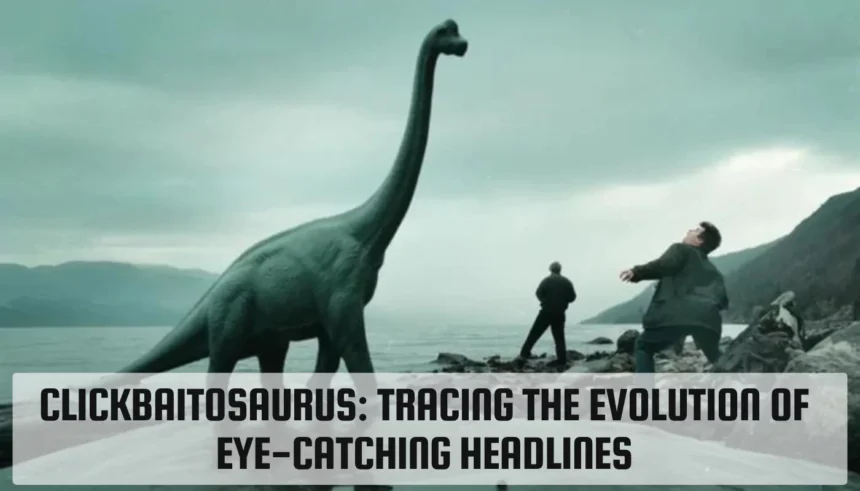Introduction to Clickbaitosaurus
Welcome to the world of Clickbaitosaurus, where headlines reign supreme and curiosity is king. In an era dominated by information overload, capturing attention has become a sport—one that many publishers have mastered with the art of clickbait. But what exactly is Clickbaitosaurus? Imagine it as a prehistoric creature that evolved from simple phrases into captivating calls-to-action designed to lure readers in like moths to a flame.
As we journey through this blog post, we’ll explore the fascinating rise of these eye-catching headlines and delve into the psychology behind their effectiveness. Whether you love them or loathe them, there’s no denying the impact they’ve had on our online reading habits. Strap in as we trace this evolution and uncover both sides of the clickbait debate!
The Rise of Clickbaitosaurus Headlines
The term “Clickbaitosaurus” emerged as a playful nod to the prehistoric nature of sensational headlines. These eye-catching phrases have evolved dramatically over the years, growing in complexity and creativity.
Initially, clickbait simply meant misleading titles designed to lure readers into clicking on articles. However, with advancements in digital media, it has morphed into an art form of sorts. The modern Clickbaitosaurus boasts catchy phrases that spark curiosity or evoke strong emotions.
As online content exploded, so did competition for attention. Publishers quickly realized that captivating headlines could significantly boost traffic. Consequently, they began crafting increasingly outrageous titles that often bore little resemblance to the actual content.
This trend fueled a cycle where shock value became paramount. Today’s Clickbaitosaurus is both revered and reviled for its ability to drive clicks while occasionally sacrificing substance for style.
The Psychology Behind Clickbaitosaurus
The allure of clickbaitosaurus headlines lies deep within our psychology. They tap into our innate curiosity and the desire to know more. This tactic preys on FOMO—fear of missing out. When we see an intriguing headline, it becomes hard to resist clicking.
Our brains are wired for instant gratification. Clickbait headlines promise quick answers or shocking revelations that satisfy this need immediately. The thrill of discovery can be intoxicating.
Emotional triggers play a crucial role as well. Words like “shocking,” “unbelievable,” and “exclusive” create urgency, prompting readers to act fast before the moment passes them by.
Moreover, social validation amplifies this effect. Seeing others engage with sensational content makes us want to join in too, reinforcing the cycle of clicks and shares that fuels these attention-grabbing titles even further.
The Controversy Surrounding Clickbaitosaurus
The emergence of Clickbaitosaurus headlines has ignited heated debates in the digital realm. Critics argue that these catchy titles mislead readers, creating a gap between expectation and reality. When users click on sensationalized content only to find it lacking substance, trust erodes.
Publishers often face moral dilemmas. They must balance enticing clicks with genuine storytelling. While clickbait can drive traffic, it risks alienating loyal audiences who seek authenticity.
Moreover, platforms like social media grapple with the consequences of rampant clickbait culture. Algorithms reward engagement metrics but fail to consider quality or integrity. This results in a flood of superficial content drowning out valuable insights.
Content creators also bear responsibility as they navigate this fine line between creativity and manipulation. The challenge lies in crafting engaging material without sacrificing honesty or depth—a task easier said than done amidst fierce online competition.
Examples of Successful Clickbaitosaurus Headlines
Successful clickbaitosaurus headlines often have a magical formula. They create curiosity and urgency, compelling readers to dive in.
Consider a headline like “You Won’t Believe What Happened When This Cat Met a Dog.” It sparks intrigue instantly. Readers are compelled to discover the unexpected twist.
Another example is: “This One Simple Trick Will Change Your Life Forever!” Such phrases promise extraordinary results with minimal effort.
Humor also plays its part—“10 Things Only Millennials Understand” resonates deeply with specific audiences, creating an instant connection.
Look at “The Shocking Truth Behind Celebrity Breakups.” This taps into our fascination with fame and relationships while hinting at juicy details that many crave to know.
Each of these examples showcases the art of crafting captivating headlines that draw clicks while feeding on human emotions and curiosity.
Negative Effects of Clickbait on Readers and Publishers
Clickbait headlines can create an illusion that quickly fades upon clicking. Readers often feel deceived when the content doesn’t deliver on the promised excitement or shock factor. This leads to frustration and a growing distrust of sources.
Publishers who rely heavily on clickbait may see short-term gains, but they risk damaging their reputation. When audiences realize they’re being misled, they are likely to disengage entirely.
Moreover, this pattern can contribute to a toxic cycle in digital media. The focus shifts from delivering valuable information to merely chasing clicks.
As trust erodes, genuine journalism suffers too. Quality content is overshadowed by sensationalist tactics that prioritize immediate engagement over lasting connections with readers.
In the long run, both readers and publishers pay a price for these tactics—one through disappointment and others through diminishing credibility in an already crowded market.
Strategies for Avoiding Clickbait and Finding Quality Content
Navigating the web can feel like walking through a minefield of clickbait. To find quality content, start by checking the source. Reputable websites often prioritize well-researched articles over sensational headlines.
Reading beyond the title is essential. Look for summaries or snippets that give insight into what you’re about to engage with. This extra step helps filter out those misleading hooks.
Utilize social media wisely. Follow accounts known for sharing reliable information and avoid trending topics unless they come from trusted sources.
Leverage tools and platforms designed to curate good content. Several apps can help highlight articles based on depth rather than intrigue.
Trust your instinct when something seems too outrageous or exaggerated. If it feels off, it probably is—your time deserves better than empty promises wrapped in flashy packaging.
Conclusion
The evolution of clickbait headlines has reshaped how we consume content. With their magnetic pull, they can drive massive traffic and engagement.
However, this allure comes with a price. Many readers feel cheated when the promised content fails to deliver value. Trust in publishers can dwindle as audiences become wary of sensationalism.
Finding a balance is essential for both writers and consumers. Quality content must rise above eye-catching phrases to foster genuine connections.
As digital landscapes continue to evolve, so too will our strategies for navigating them. The quest for meaningful information persists amidst the noise of catchy titles.
Staying informed empowers readers while encouraging creators to prioritize substance over style. The journey towards better online experiences is ongoing, inviting fresh perspectives along the way.
FAQs
Q: What is a Clickbaitosaurus?
A: A Clickbaitosaurus refers to headlines or content that are designed primarily to attract clicks, often at the expense of delivering substantial information. These sensationalized titles typically exaggerate details or create intrigue that may not align with the actual content.
Q: Why has clickbait become so popular?
A: With the increasing competition for attention online, publishers resort to catchy and enticing headlines. The need to stand out in crowded feeds drives many towards clickbait strategies as they aim for higher engagement rates.
Q: Are all eye-catching headlines considered clickbait?
A: Not necessarily. Eye-catching titles can be informative and accurate while still drawing readers in. The key distinction lies in whether the headline matches the substance of the article.
Q: How can I avoid falling for clickbait?
A: To steer clear of misleading content, focus on reputable sources, read beyond just the headline, and look for any corroborating evidence before fully engaging with an article.
Q: Is there a future without clickbait?
A: As long as digital media relies on advertising revenue driven by clicks, some form of headline manipulation will likely persist. However, there is growing awareness among audiences about quality over sensationalism which could lead to more authentic approaches over time.
Q: Can publishers survive without using clickbait tactics?
A: Yes! Many respected outlets prioritize integrity over sensationalism and maintain loyal readerships through trustworthiness rather than gimmicks. Quality journalism can thrive amid a sea of flashy headlines if it meets reader expectations consistently.







